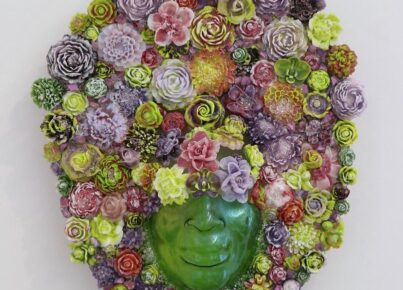[dropcap custom_class=”normal”]Enugu based-artist, Krydz Ikwuemesi opens his solo art exhibition The Village Square on May 7, 2015 at International Institute for Creative Development (IIDC), Maitama, Abuja. The exhibition, according to a statement features composite installation. [/dropcap]
Associate Professor of Fine Art at University of Nigeria (UNN), Nsukka, Ikwuemesi, in his artist statement discloses how the works attempt to view the world’s acclaimed advancement.
“In this exhibition, I am looking at the compactness of the wide world in this age of the cyber magic. Yes. In spite of its expansiveness, the world seems so small.
This article was published in ngrguardiannews.com
We can see it all from our little corner. There is so much motion, yet little movement. Globalization takes its toll. The world changes. But we have not changed much. We are meaning-seeking animals trapped in a world where meaning has remained meaningless and ever elusive.
The world, the expansive but small village square we now all share, continues to challenge us; we are ever surrounded by the same worries and forces that shaped the consciousness of those who went before us.
The new world is a village, after all; it is the old village re-varnished. We have been here before and will ever be. We go forward, no doubt. But we will return, now and again, like Sankofa, to seek new crumbs along foot-beaten, old tracks; to seek new meanings in old visions.”
“Uli is the Igbo name for the indigo dye obtained from several species of plants and used to make the intricate monochromatic drawings on the body.
Traditional paintings on walls are also known as uli in Igbo land, although the indigo dye does not form part of the palette in such painting. Both the body and wall variants are essentially a female tradition.
Some of the possibilities in uli have been explored and exploited by artists of the Nsukka School over the last 30 from a modern perspective. This exhibition only attempts to re-engage the uli idiom in a way that vividly reconnects with the uli classics, as my recent research on the art and culture of the Ainu of Japan has strengthened my conviction that uli can be fruitfully exploited and aligned with contemporary reality, even beyond the homestead.
“The exhibition has been conceived as an installation with two collapsible Japanese-byobu-style panels on either side of the hall to give the impression of Igbo dwarf fence with uli mural on it. There are other paintings to complement the “fence”.
They embody a variety of subjects and themes. In the middle of the hall are objects like pots and stools alluding to forces and interests that shape our world and the contested space within.
The dominant uli colours are used to mediate the past and the future, that is, the future as offspring of our actions in the imagined present. To this extent, The Village Square captures the micro and macro essences of our world and our place in it, its meaning and meaninglessness, its fullness and emptiness, its flux and permanence.
In sum, it is a graphic comment on the primitive instincts at the heart of our dynamic and supersonic world. “
Article by Tajudeen Sowole
Source: www.ngrguardiannews.com




